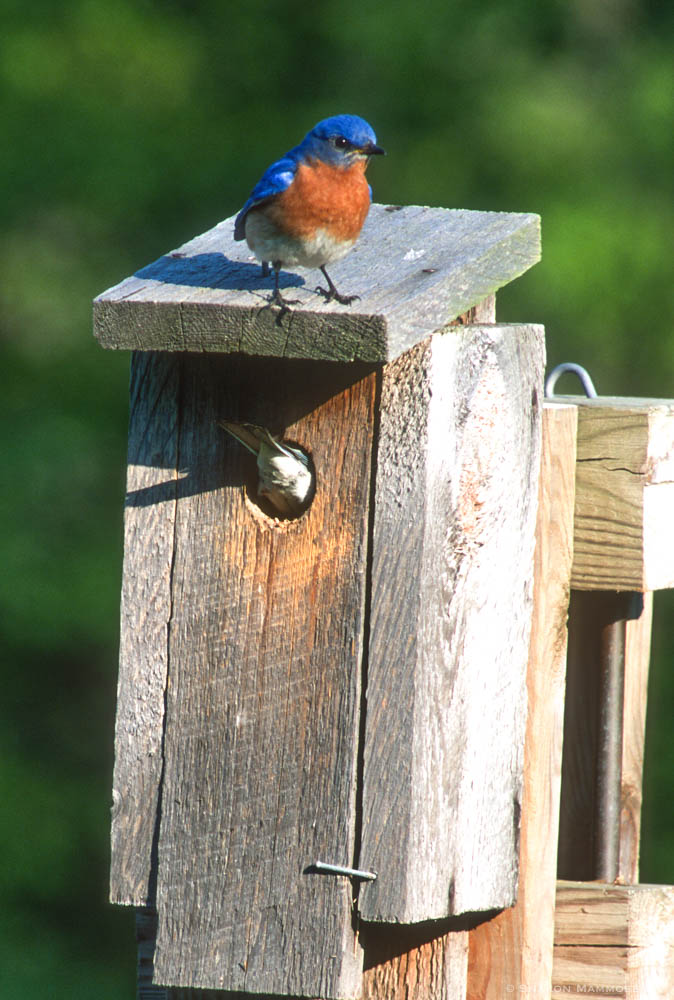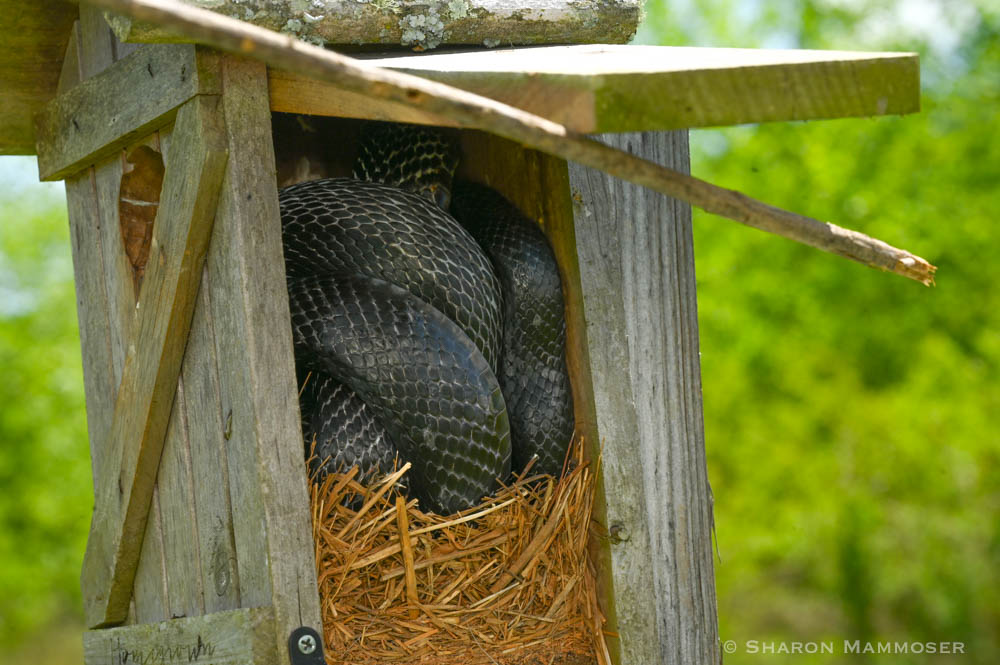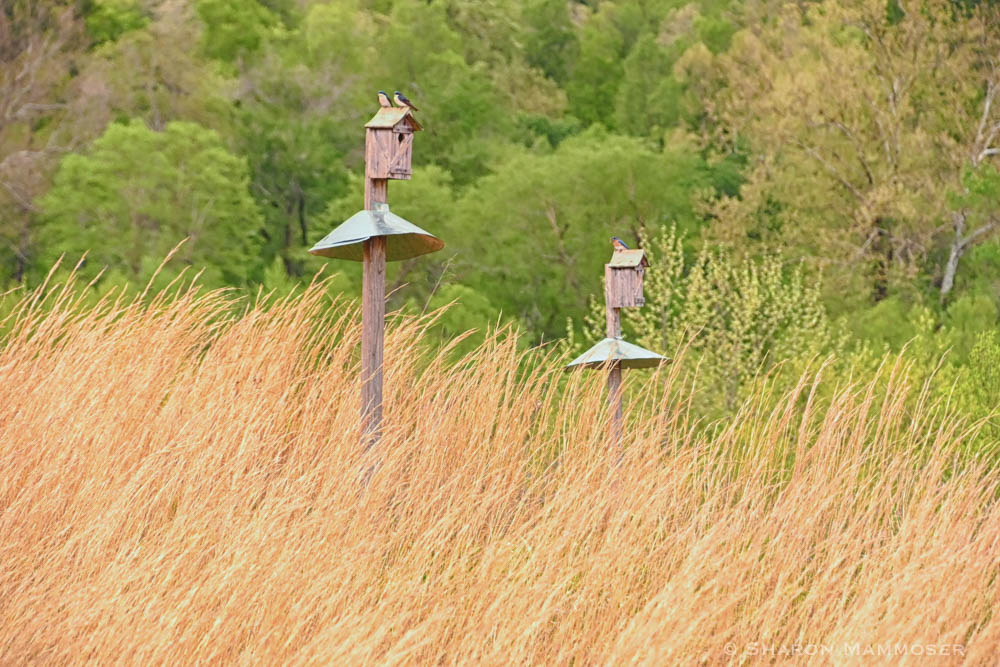Got Bluebirds? Set Them Up for Success with These Four Tips

Article and photography by naturalist Sharon Mammoser.
Did you know some of our most beloved songbirds, including eastern bluebirds, chickadees, and white-breasted nuthatches, are cavity nesters? So unlike robins, blue jays and many other birds that collect sticks and then build their own nests, these birds use old woodpecker holes or hollow spaces in standing dead trees to raise their young. These days standing dead trees, or snags as they are called, are often cut down, so cavity nesters are facing even more challenges.
The good news is that many of these birds will readily use nesting boxes, even in neighborhoods. If you have a sunny, open area, some taller grass or flowers, along with a few trees for the birds to perch, and a reliable water source, you may have a good spot for a bluebird box. However, here are two other, but very important things to consider when deciding if your yard is a good place for a bluebird box: Do you use pesticides or other chemicals in your yard? Does your cat or your neighbor’s cat roam freely outside? If you answered yes to either question, a bluebird box in your yard may not be the best idea because the bluebirds will already have two things going against them. Bluebirds –and other songbirds– feed their babies insects, so a yard that’s been treated with chemicals intended to kill insects is not going to help them. And the cats? It’s a fact that outdoor cats kill millions of animals each year, including birds. Cats can jump on the nest box and harass the parents. They can reach into the box and hurt or kill the babies. And then, when your bluebirds fledge, there’s a good chance the cat will make an easy meal out of them before they’ve even had a chance to learn how to survive. Better in my opinion not to install a doomed nest box.
If you’ve determined your yard IS a good place for a bluebird box, now what? Well, if you have space and time, you could make your own nest boxes. The Oklahoma Ag Extension offers three great designs that can help get you started. Or, if you want to buy a box, here is one I would recommend from a family-owned company called Nature’s Way. (Also available on Amazon.) I like it because it has an easy clean-out door on the side, (ideal when you’re monitoring the box), sloped roof, air vents, drainage holes, no perch, interior grooves (so the young birds can climb to the hole), the right size entrance hole (1.5inches), a mesh floor, and untreated cedar wood.
Even though it’s the middle of winter, bluebirds are house hunting right now, checking out the possibilities despite that the time when they will actually need the space is still months away. They definitely like to plan ahead! You too can plan ahead, getting your boxes ready and installed ahead of time. Here are four tips to set your bluebirds up for success:
- Get your bluebird boxes out early, preferably now, or soon. As I said, bluebirds like to explore their choices ahead of time so getting them out early will increase the chance for success. Ideally you should have them out by February. But don’t despair if you’re not ready now! Just get them out as soon as you can.
- Location is crucial. Place the boxes in a sunny location, away from deep shade and bird feeders. Face them east, northeast, or southeast and put them 5-10 feet above the ground, preferably facing a small tree or shrub so the fledglings have a safe place to aim for on their initial flying attempts.
- Put your box on a pole or post and ALWAYS add a predator guard to the post. Trees or fences are the least ideal location for a bluebird box because predators can easily reach them and feast on the growing babies. Always add a predator guard to the post–not just the block of wood by the entrance hole that is often called a predator guard. I’ll tell you why with a story. Last spring I was monitoring 8 bluebird boxes in a large meadow on a property that Conserving Carolina owns. The boxes are spread out, in pairs (more on that in a minute), and each post had a homemade steel funnel, predator guard around it to deter predators. When I reached a box beside the pond, I could tell it was heavier than it should be. Cautiously I opened the box and guess what I saw?!

A very large black rat snake was coiled in the box! When I looked closely, I could see that the homemade baffle had a small— less-than-two-inch space where the nail had secured it to the post. Amazingly, this very large snake had squeezed in that small hole and then crawled into the box via the window opening. Most people are shocked to learn this is possible! And very likely. Snakes are amazing climbers!

The way to protect your bluebirds from most predators is to install a predator guard ON THE POST. The most effective guard is a stovepipe baffle 8 inches in diameter, and 8 to 24 inches long and secured on the post near the top. Alternatively, you could use a PVC pipe section, or a steel guard, like the one shown above. Make sure it fits snugly against the pole as I learned the hard way. This predator guard will not protect against birds of prey, bears, or cats that can jump onto the top of the box, but it certainly gives the birds a better chance at success from predators like snakes and raccoons.
- Put your bluebird boxes in pairs to reduce competition from other native cavity nesters like swallows, chickadees, and nuthatches. If you only put out one bluebird box, often the other birds are more aggressive than bluebirds and will grab the box before the bluebird, or worse, take over after a bluebird has secured the box, leaving the bluebirds homeless. To help with this problem, you can install boxes in pairs, 5-15 feet apart. Two bluebird pairs won’t nest that close together but other birds like swallows or chickadees don’t mind the close proximity. And that way, you’re helping out two native species of birds, instead of just one.
Want to offer other birds nesting boxes? Here is a great resource from NestWatch.org.
And if you are wondering whether or not to clean out your bluebird boxes after the birds have fledged, there is a great debate about that. Here’s some information to help you decide: To clean or not to clean?
Good luck and happy bluebird watching!
